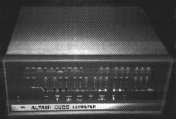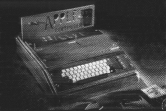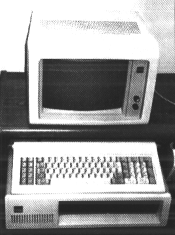|
1974 The first personal computer advertisements in the press.
SCELBI (SCientific, ELectronic, and Biological «scientific, electronic and biologichesky»). PDP-1, a SCELBI Computer Consulting, Milford (Conn.), advertisements appeared in March 1974 in the journal «QST»
1974 First for sale kit for assembling a personal computer.
Mark-8 designed by Jonathan Titus (Jonathan Titus) from 1973 to 1974.
1975 First mass produced and placed on the sale of a personal computer (in a set for assembly and assembly)
Altair 8800 - designed by Edward Robertson (Edward Roberts), William Yatesom (William Yates) and Jim Baibo (Jim Vubee) from 1973 to 1974.
 First Altair 8080 used the Intel processor and 4 KB of memory. By the order of Edward Roberts of the company MITS, distributing computer, Bill Gates and Paul Allen wrote a BASIC language interpreter, vtisnuv it in the existing 4 KB (that is still proud of B. Gates). This was the beginning of software company Microsoft. First Altair 8080 used the Intel processor and 4 KB of memory. By the order of Edward Roberts of the company MITS, distributing computer, Bill Gates and Paul Allen wrote a BASIC language interpreter, vtisnuv it in the existing 4 KB (that is still proud of B. Gates). This was the beginning of software company Microsoft.
1975 the first integrated text-graphics display. The first implementation of hypertext, links and sites of branching.
GUI (Graphics User Interface) - Developed Engelbartom Douglas (Douglas Engelbart) and the Research Center augmentatsii (Augmentation Research Center) from 1962 to 1975
1975 The first personal computer IBM (IBM Portable Computer).
IBM 5100 - developed by IBM Corporation from 1973 to 1975, unfortunately markeyting and sales of the device were unsuccessful.
 A portable computer with a tape device I / O and a tiny display. This IBM 5100 - one of the first personal computers. IBM 5100 PortableComputer was the first (and unsuccessful) attempt to form the IBM personal computer in late 1974. He weighed about 23 kg and cost about 10000 dollars. We have built a computer tape drive, small screen and the ability to manage programs in Basic or APL - (programming language created by IBM). IBM has used its own components and not rely on microprocessor Intel, in contrast to the next, more successful models. The monitor display 16 lines of 64 characters each, expanding the memory up to 64 Kbytes, and the tape devices use standard music cassette, which retains approximately 200 KB of data. Kompyuter designed for use in small businesses, but high cost, the disadvantages of the interface and the inability to exchange data with other computers have limited its use and is not allowed to become a widely used personal computer. A portable computer with a tape device I / O and a tiny display. This IBM 5100 - one of the first personal computers. IBM 5100 PortableComputer was the first (and unsuccessful) attempt to form the IBM personal computer in late 1974. He weighed about 23 kg and cost about 10000 dollars. We have built a computer tape drive, small screen and the ability to manage programs in Basic or APL - (programming language created by IBM). IBM has used its own components and not rely on microprocessor Intel, in contrast to the next, more successful models. The monitor display 16 lines of 64 characters each, expanding the memory up to 64 Kbytes, and the tape devices use standard music cassette, which retains approximately 200 KB of data. Kompyuter designed for use in small businesses, but high cost, the disadvantages of the interface and the inability to exchange data with other computers have limited its use and is not allowed to become a widely used personal computer.
1976 The first highly successful personal computer sold.
Apple] [ developed by Steve (Steve Jobs) and Steve Wozniak (Steve Wozniak) from 1974 to 1976.
 The first computer Arrle collected at the knees just are not too different from their fellow (Altair and others). Only line Arrle] [made on a commercial basis, has become extremely popular. A bit later poyavilisArrle III and Lisa, and only then - Macintosh, released as a Mac 128K (with all the novelties, the company attributed to Apple as a pioneer). Apple] [has 48 Kbytes of memory and S.0.S. (Sophisticated Operating System - «intricate operating system»); he established a general trend komyuterizatsii and engendered fanaticism, which prevents the adequate perception of the company's computers. The first computer Arrle collected at the knees just are not too different from their fellow (Altair and others). Only line Arrle] [made on a commercial basis, has become extremely popular. A bit later poyavilisArrle III and Lisa, and only then - Macintosh, released as a Mac 128K (with all the novelties, the company attributed to Apple as a pioneer). Apple] [has 48 Kbytes of memory and S.0.S. (Sophisticated Operating System - «intricate operating system»); he established a general trend komyuterizatsii and engendered fanaticism, which prevents the adequate perception of the company's computers.
1979 Sendmail
SendMail program developed by Eric Ollmanom in 1979g.Student University of California at Berkeley, Eric Ollman was a program for sending messages between computers on the network ARPANET.Pozzhe Ollman transformed it into a program sendmail.Segodnya program is used to deliver mail to more than 75% of mail servers, Internet.
1979 Birth of BSD UNIX.
BSD UNIX developed at Berkely university 1979. Company AT & T announces plans to commercialize UNIX. Therefore, the University of California at Berkeley, has been prepared by their own kind of UNIX, called BSD (Berkely Software Distribution) UNIX. Initially, BSD UNIX have adopted commercial suppliers such as DEC and Sun. Subsequently, AT & T and Sun have agreed to merge their versions of UNIX, forcing competitors (DEC, HP and IBM) to create the organization of Open Software Foundation.
1981 successfully sold the first personal computer IBM PC.
IBM PC - developed by IBM c 1978 to 1981.
 The original PC - a model 1983 with 640 Kbytes of RAM, but most early models may have only 64 KB on the motherboard. This PC has two specific pyatidyuymovyh drive to floppy disk Ket 360 KB, one of IBM, and the other - from some third firm (already begun!). Consumes only 63.5 Watts. Green screen (no poreklyuchatalya «on / off -») and «click» keyboard with small keys Shift and Return With This could be done? Not much, but look where that led ... IBM introduced the Personal Computer (PC), or a personal computer (PC), 12 August 1981. At that time, most computers were still 8-bit and can handle 8 bits of information per clock cycle. IBM revolutionized the computer industry, entering the market with the PC based on Intel 8088 processor, compatible with the computers at the 8-bit processors, Intel, but the process up to 16 bits of information per clock cycle (ie, he was 16 - bit). PC shows an example of scalable architecture, known as «open architecture», which allowed users to add new components to their computers without changing the entire device. The original IBM PC (model 5150) came standard with 16 KB of RAM (chips Kilobit 9h16), expandable to 64 KB on the motherboard (the bank set aside three more) and up to 540 Kbytes of possible total memory (640 KB are not due to hardware error) was one-TTL-monitor (model 5151) - where the green on black display 25 lines of 80 characters and is connected to the AC-power supply jack on the computer (63.5 W), so it does not need to own vyklyuchyatele; Monochrome graphics adapter with a parallel port for your printer: pospedovatelny port: two seats for the full height of the external devices, floppy disk drive, capable of use odnostoronnnie and ds, single-and double-density (capacity of 80-360 Kb). IBM PC-DOS v1.1 restrict density floppy 8 sectors per track, or 320 Kbytes of disk space, but in v2.0 this restriction was lifted (version 1.0 was so primitive that it is practically impossible to use, and soon it was replaced ; B. Gates has not yet departed from Basic). The second parallel port, a second floppy disk drive 360 KB, color CGA-adapter (no printer port) and color monitor (model 5152) were supplied separately. The second version of IBM PC (with the same model number) was already 64 Kbytes of memory (chip Kilobit 9h64), expandable to 256 KB on the motherboard (also three more free bank) in the total number of 540 Kbytes, and was named IBM Personal Somputer. Due to scalability and openness of the architecture outside manufacturers quickly to produce the hard drives, which added new features for storing programs and data on the IBM PC. The original PC - a model 1983 with 640 Kbytes of RAM, but most early models may have only 64 KB on the motherboard. This PC has two specific pyatidyuymovyh drive to floppy disk Ket 360 KB, one of IBM, and the other - from some third firm (already begun!). Consumes only 63.5 Watts. Green screen (no poreklyuchatalya «on / off -») and «click» keyboard with small keys Shift and Return With This could be done? Not much, but look where that led ... IBM introduced the Personal Computer (PC), or a personal computer (PC), 12 August 1981. At that time, most computers were still 8-bit and can handle 8 bits of information per clock cycle. IBM revolutionized the computer industry, entering the market with the PC based on Intel 8088 processor, compatible with the computers at the 8-bit processors, Intel, but the process up to 16 bits of information per clock cycle (ie, he was 16 - bit). PC shows an example of scalable architecture, known as «open architecture», which allowed users to add new components to their computers without changing the entire device. The original IBM PC (model 5150) came standard with 16 KB of RAM (chips Kilobit 9h16), expandable to 64 KB on the motherboard (the bank set aside three more) and up to 540 Kbytes of possible total memory (640 KB are not due to hardware error) was one-TTL-monitor (model 5151) - where the green on black display 25 lines of 80 characters and is connected to the AC-power supply jack on the computer (63.5 W), so it does not need to own vyklyuchyatele; Monochrome graphics adapter with a parallel port for your printer: pospedovatelny port: two seats for the full height of the external devices, floppy disk drive, capable of use odnostoronnnie and ds, single-and double-density (capacity of 80-360 Kb). IBM PC-DOS v1.1 restrict density floppy 8 sectors per track, or 320 Kbytes of disk space, but in v2.0 this restriction was lifted (version 1.0 was so primitive that it is practically impossible to use, and soon it was replaced ; B. Gates has not yet departed from Basic). The second parallel port, a second floppy disk drive 360 KB, color CGA-adapter (no printer port) and color monitor (model 5152) were supplied separately. The second version of IBM PC (with the same model number) was already 64 Kbytes of memory (chip Kilobit 9h64), expandable to 256 KB on the motherboard (also three more free bank) in the total number of 540 Kbytes, and was named IBM Personal Somputer. Due to scalability and openness of the architecture outside manufacturers quickly to produce the hard drives, which added new features for storing programs and data on the IBM PC.
|



